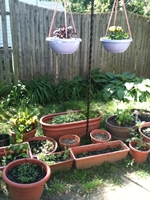 She spends most of her time in a cocoon she makes of my quilt. Sometimes she buries her head; sometimes she stares into space.
She spends most of her time in a cocoon she makes of my quilt. Sometimes she buries her head; sometimes she stares into space.
I don’t know if it’s her 9th life that she’s nearing the end of; over the past 17 years she certainly has gone through several, including last February, when I (and the vet) thought it might well be her last.
They were are able to diagnose and treat her then for pancreatitis, and she rebounded. But not this time.
The blood and other tests the vet did the other day indicate she’s healthy. Except she’s not. Her x-ray showed some weird pockets of fat where there usually aren’t any. More tests might figure out what that’s all about. But I have decided that there will be no more tests. She’s 17 and has had a good life.
 She’s been coming to sit (or get into her “begging” position) at my feet and make strange staccato meows as though she’s trying to tell me something. If I pick her up and put her in my lap, she makes a whining sound low in her throat. If I pet her, she sometimes hisses.
She’s been coming to sit (or get into her “begging” position) at my feet and make strange staccato meows as though she’s trying to tell me something. If I pick her up and put her in my lap, she makes a whining sound low in her throat. If I pet her, she sometimes hisses.
Obviously, something is wrong.
She eats a little. Uses the litter box a little. Sometimes she stops whatever she’s doing and just sits, silent and glassy-eyed, as though introspecting.
So, I’m just giving her “comfort care” until the next stage of whatever is going on inside her. When she becomes “uncomfortable,” I will take the next step and end her days.
She has been my one close and constant companion, has been with me through the deaths of relationships, the deaths of family members. I will do for her what I tried to do for them — the best I can to make the end of her days easier.
Her name is Calli.



 Except for a few mounted in the exhibit room, butterflies fly free at the
Except for a few mounted in the exhibit room, butterflies fly free at the  The thousands of butterflies are free to land wherever they want, and this one took a real liking to one woman’s hair. (Must have been her shampoo.) None of them chose to land on me. (Must have been my hair spray.)
The thousands of butterflies are free to land wherever they want, and this one took a real liking to one woman’s hair. (Must have been her shampoo.) None of them chose to land on me. (Must have been my hair spray.)




 The seeds I started much too early, encouraged by early warm weather, are flourishing in their separate pots — swarms of marigolds grown from the seeds of last year’s plants that will wind up as companion plantings in our vegetable garden; some strange husky
The seeds I started much too early, encouraged by early warm weather, are flourishing in their separate pots — swarms of marigolds grown from the seeds of last year’s plants that will wind up as companion plantings in our vegetable garden; some strange husky 
 Some 25 years ago, a friend gave me a clipping from her Wandering Jew plant that she had grown from a clipping a friend had given her.
Some 25 years ago, a friend gave me a clipping from her Wandering Jew plant that she had grown from a clipping a friend had given her.